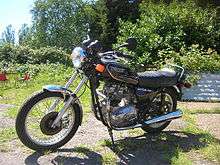Triumph Tiger Daytona
|
1971 Triumph T100R Daytona | |
| Manufacturer | Triumph |
|---|---|
| Also called | T100R |
| Production | 1967 - 1974 |
| Engine | 490 cc air-cooled, ohv parallel-twin |
| Power | 41 bhp (31 kW) @ 7,400 rpm |
| Transmission | 4-speed gearbox with chain final drive |
| Wheelbase | 53.6 inches (1,360 mm) |
The Triumph Tiger Daytona is a motorcycle made by Triumph from 1967 to 1974.[1]
Development

The 'Daytona' name was derived from American rider Buddy Elmore's win at the 1966 Daytona 200 race held at the Daytona International Speedway in Daytona Beach, Florida.[2] He achieved an average speed of 96.6 mph (155.5 km/h) on a 'works special' Triumph Tiger 100 and secured Triumph's first Daytona road race victory.[1]
The 500 cc Triumph Tiger 100 Daytona (T100T) was developed by Triumph's Chief Engineer and designer Doug Hele and launched as a production motorcycle the following year.[1] Based on the setup developed for the 1966 Daytona races, the T100T was fitted with a new cylinder head and twin Amal Monobloc carburettors. In the head, the valve angle was reduced by two degrees and the intake valve size increased as a result of testing; the valves on test engines had a worrying tendency to meet during the overlap period.[3]
Derived from Edward Turner's original twin cylinder design and a development of the Triumph Tiger, the 'Daytona' sacrificed low-speed tractability for a pronounced power step at 3,500 rpm that helped it to compete with the advanced designs from Japanese manufacturers like Honda. As well as decreased engine flexibility, however, the increase in power reduced the life of the valve gear, leading to heavy oil consumption.
Gary Nixon won the 1967 Daytona 200 race on the newly designated Triumph Daytona.
In 1969, the timing side main bush was replaced with a ball-bearing race and a roller on the drive side which helped engine life.[4] At the 1969 Belgian motorcycle Grand Prix on the Circuit de Spa-Francorchamps in the Ardennes, Triumph's factory tester Percy Tait led the world champion Giacomo Agostini for three laps and finished second at an average speed of 116 mph (187 km/h) on the Daytona.[5]
The later model Daytonas were further upgraded with special E3134 race profile cams for both inlet and exhaust and strengthened followers, valve guides, and performance connecting rods.[6] While the Triumph 650 Bonneville and new 650 Tiger models received a new oil in frame and dramatically changed geometry for 1971, the Daytona kept the traditional unit era frame, which kept the frame and seat height of the previous model years.[7] The last Daytona model, the T100D, was fitted with a disc front brake but only 14 were built before the closure of the Meriden works in February 1974 and the 18-month 'sit-in' industrial action after which the Daytona models were discontinued.[1]
Triumph Daytona 600 cc prototype

A 600 cc Triumph Daytona 600 was manufactured in 1983 by Triumph Motorcycles in their Meriden factory. It was a short-stroke twin-carburettor version of the 650 cc Triumph TR65 Thunderbird with an 8.5:1 compression ratio, but it was exhibited at the 1983 motorcycle show at the National Exhibition Centre as a new model for their (eventually unrealised) 1984 range. Unique for that year's home market models, it featured rear-set foot rests and a plastic 'ducktail' rear end over the short chromed rear mudguard from the Triumph T140 TSX. Although sporting a front disc brake, it retained the drum rear brake of the TR65 Thunderbird.[8][9] With a claimed top speed of over 100 miles per hour, the target market was said by Meriden to be newly qualified riders for whom the cost of insurance made their 650cc and 750cc bikes prohibitively expensive.[9] Two prototypes were made, one show version with electric start, the other with a kick start for testing. The latter, the only one left after the Meriden factory finally closed in 1983, is on display at the London Motorcycle Museum.[10]
References
- 1 2 3 4 "Daytona wIn". Retrieved 2009-03-08.
- ↑ de Cet, Mirco (2004). Essential Superbike. Motorbook/MBI Publishing Company. p. 139. ISBN 0-7603-2007-1.
- ↑ "Triumph T100R Daytona Super Sports" (PDF). Retrieved 2009-03-08.
- ↑ Westworth, Frank. The British Classic Bike Guide. Haynes Publishing. ISBN 1-85960-426-9.
- ↑ Reynolds, Jim (13 December 2001). "Doug Hele". The Independent. Retrieved 2009-03-08.
- ↑ "Triumph T100C and T100R". Retrieved 2009-03-08.
- ↑ "Triumph T100 Daytona 1972 in for restoration". Retrieved 2012-05-24.
- ↑ Guide Lines(Cycle Guide 6/83)
- 1 2 Daytona Return ! Motor Cycle News (02.03.83)
- ↑ Rosamond, John Save The Triumph Bonneville ! The Inside Story Of The Meriden Workers Co-Op (Veloce 2009)